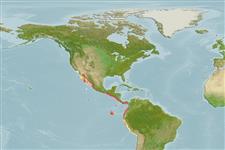Common names from other countries
Environment: milieu / climate zone / depth range / distribution range
Ökologie
seewasser demersal; tiefenbereich 23 - 306 m (Ref. 9342). Subtropical; 34°N - 19°S, 120°W - 70°W
Eastern Pacific: Playa del Rey in southern California, USA to Peru.
Size / Gewicht / Alter
Maturity: Lm ? range ? - ? cm
Max length : 42.0 cm TL Männchen/unbestimmt; (Ref. 9342); max. veröff. Gewicht: 680.00 g (Ref. 40637)
A sharp spine projecting anteriorly from ventral border of urohyal (Ref. 40817).
Probably forms schools and lives near the bottom in deep waters (Ref. 9342). Of some commercial importance in zones where it is abundant (Ref. 9342).
Life cycle and mating behavior
Maturities | Fortpflanzung | Spawnings | Egg(s) | Fecundities | Larven
Eschmeyer, W.N., E.S. Herald and H. Hammann, 1983. A field guide to Pacific coast fishes of North America. Boston (MA, USA): Houghton Mifflin Company. xii+336 p. (Ref. 2850)
IUCN Rote Liste Status (Ref. 130435)
CITES (Ref. 128078)
Not Evaluated
Bedrohung für Menschen
Harmless
Nutzung durch Menschen
Fischereien: weniger kommerziell
Tools
Zusatzinformationen
Download XML
Internet Quellen
Estimates based on models
Preferred temperature (Ref.
115969): 13 - 21.4, mean 15.2 (based on 78 cells).
Phylogenetic diversity index (Ref.
82804): PD
50 = 0.6250 [Uniqueness, from 0.5 = low to 2.0 = high].
Trophic level (Ref.
69278): 3.7 ±0.5 se; based on size and trophs of closest relatives
Widerstandsfähigkeit (Ref.
120179): mittel, Verdopplung der Population dauert 1,4 - 4,4 Jahre. (Preliminary K or Fecundity.).
Fishing Vulnerability (Ref.
59153): Low to moderate vulnerability (32 of 100).
